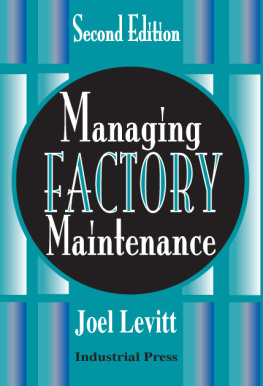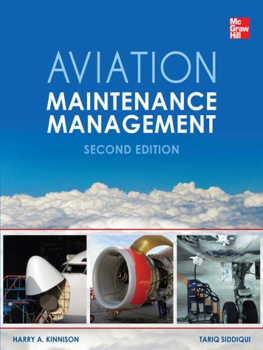Joel Levitt - Managing Factory Maintenance
Here you can read online Joel Levitt - Managing Factory Maintenance full text of the book (entire story) in english for free. Download pdf and epub, get meaning, cover and reviews about this ebook. publisher: Lightning Source Inc., genre: Romance novel. Description of the work, (preface) as well as reviews are available. Best literature library LitArk.com created for fans of good reading and offers a wide selection of genres:
Romance novel
Science fiction
Adventure
Detective
Science
History
Home and family
Prose
Art
Politics
Computer
Non-fiction
Religion
Business
Children
Humor
Choose a favorite category and find really read worthwhile books. Enjoy immersion in the world of imagination, feel the emotions of the characters or learn something new for yourself, make an fascinating discovery.
- Book:Managing Factory Maintenance
- Author:
- Publisher:Lightning Source Inc.
- Genre:
- Rating:4 / 5
- Favourites:Add to favourites
- Your mark:
- 80
- 1
- 2
- 3
- 4
- 5
Managing Factory Maintenance: summary, description and annotation
We offer to read an annotation, description, summary or preface (depends on what the author of the book "Managing Factory Maintenance" wrote himself). If you haven't found the necessary information about the book — write in the comments, we will try to find it.
Managing Factory Maintenance — read online for free the complete book (whole text) full work
Below is the text of the book, divided by pages. System saving the place of the last page read, allows you to conveniently read the book "Managing Factory Maintenance" online for free, without having to search again every time where you left off. Put a bookmark, and you can go to the page where you finished reading at any time.
Font size:
Interval:
Bookmark:

Managing Factory
Maintenance
SECOND EDITION
Joel Levitt
Springfield Resources,
401 Rolling Hill Dr.
Plymouth Meeting, Pa. 19462
Voice: 610-278-7550
fax: 610-278-7552
Industrial Press Inc.
New York
Managing Factory
Maintenance
SECOND EDITION
Library of Congress Cataloging-in-Publication Data
Levitt,Joel, 1952
Managing factory maintenance / by Joel Levitt.--2nd ed.
p. cm
ISBN 978-0-8311-9096-5
1. Plant maintenance--Management. I. Title
TS192.L47 2004
658.202--dc22
2004017939
Managing Factory Maintenance
Second Edition 2005
Industrial Press Inc.
200 Madison Avenue
New York, New York 10016
Coppyright 2005. Printed in the United States of America.
All rights reserved. This book or parts thereof may not be reproduced,
stored in a retrieval system or transmitted in any form without the
permission of the publisher
Text and Cover Design: Janet Romano
Manageing Editor: John Carleo
Disclaimer: The advice given in this book is general. The judgment of qualified people is essential to determine the fitness of any of these statements for your use. All statements must be adapted to the site conditions of any individual shutdown. The author and publisher take no responsibility for any adverse outcomes.
10 9 8 7 6 5 4 3 2 1
There have been several changes in the field of managing factory maintenance since 1996 when the first edition came out. This revised edition has been extensively rewritten and reorganized to reflect the changes.
The two biggest changes are the globalization of the location of production and the changing of the guard of the leadership of maintenance. Each trend was clearly present in 1996 but neither had become the 800-pound gorilla that they are today (they were merely 400-pound gorillas back then). These two monumental shifts present peril and (as always) tremendous opportunity.
The book is organized to more closely reflect how it is to be used. The book can be read as a coherent story about managing factory maintenance but it is also designed for a person interested in or responsible for maintenance to get relatively specific answers to any big questions they might ask. The chapters are now presented in a context of major sections that tell the story of maintenance management in factory settings.
Section: What is the Context for Managing Maintenance?Why we are in this situation: What happened to produce the situation we are now in. What potential problems and new opportunities result from the present situation? What bosses really want: There is a lot of noise from management. What do they really want from the maintenance effort? When the comments are examined it is found that top management is really asking for something pretty simple. Management wants to run the factory with 100% availability, safely, and in compliance with the law, without any maintenance department at all!
Specifics to improvement of maintenance and production: To achieve that goal we must increase our effectiveness, reduce waste, and do more with fewer people.
World Class Maintenance Management visited and revisited. Ive thought about world class maintenance for the last 8 years. Here is the original view and some revised thoughts.
Section: Evaluating current maintenance practices. Many questions have changed, moved or been eliminated from the first edition. Maintenance processes have not really changed in 8 years. What has changed is the enabling technologies. What has also changed is the deep proliferation of systems in maintenance departments. As with every other area of the business, computer expertise is moving rapidly to the masses from the IT departments.
Section: Maintenance processes: Description of the processes to deliver maintenance services. This section has been reorganized to suit new techniques and technologies.
Quality improvement: We learned to importance of quality in manufacturing in the 1980s and 1990s. Quality has had a chance to merge into the culture now.
Section: Maintenance process aids: Formally we thought that the initials represented maintenance management in themselves. If we had PM, TPM, RCM, or PMO we thought we were doing maintenance management. Actually these initials represent process aids. The underlying processes must be whole and complete for the aids to help us. Section: Maintenance strategies: Approaches to deterioration: Strategies must fit the circumstances. To the degree that we remember this axiom we will be successful in organizing and improving the maintenance effort.
Section: Maintenance interfaces: Where does maintenance fit in? Maintenance has interfaces to all other parts of the organization. In this section, we discuss effective ways of interacting with our colleagues.
Section: Personal development and personnel development: Whether we like it or not, we are in the training and development business. This section is designed to help the leadership organize and regularize training and development.
Why we are in this situation in the first place
Managing the need for maintenance is essential for any organization to survive in manufacturing .. Of course, a few companies (like a notable one in the steel business) have abandoned manufacturing because they feel they can make more money in another field. The mission of this work is to identify the challenges and opportunities presented by staying in the manufacturing field.
Our greatest challenge is two pronged.
Competition: A manufacturing manager was complaining that low wages were causing jobs to go off shore. He wanted the government to help him compete with the foreigners. This conversation could have been happening in Detroit, Rochester, or Omaha. In fact, the conversation happened in Kuala Lumpur, the capital of Malaysia. The jobs in question were moving from factories in Malaysia to new factories in Vietnam. In the next few years, it is expected that Vietnam will be a low wage-manufacturing powerhouse.
The first prong of the challenge is the increasing globalization of the location of production. Corporate management is seeking the lowest cost of production irrespective of other factors. In the US, we complain about the low cost of foreign labor but in fact, this is a challenge for all manufacturing centers worldwide. The low cost producers of today have to look out for the lowest cost producers of tomorrow.
In the US, manufacturing jobs have been moving to southern states for 40 years. It took 25 years or more to move production from domestic factories to plants first in Mexico then in Asia. The process is speeding up. It took only a few years for Korea, Taiwan and other powerhouse manufacturing centers to realize they could also save money by going to China or Vietnam. Where process innovation to offset advantages in labor cost is not taking place you can count on manufacturing seeking the lowest labor cost.
Loss of old timers with their skills due to retirement and retrenchment: The second prong of the challenge is due to demographics, business reorganization, and rapid changes in technology. Industrialized countries are losing their most experienced workers at an extremely rapid rate. By rapid we mean, for example, a power plant in the western United States will lose 66% of its maintenance workforce to retirement in the next 5 years!
The demographics are worse in Japan and Europe. In the US the higher rate of immigration is partially shielding us from the effects of the aging of the population and the lowered birth rate.
Next pageFont size:
Interval:
Bookmark:
Similar books «Managing Factory Maintenance»
Look at similar books to Managing Factory Maintenance. We have selected literature similar in name and meaning in the hope of providing readers with more options to find new, interesting, not yet read works.
Discussion, reviews of the book Managing Factory Maintenance and just readers' own opinions. Leave your comments, write what you think about the work, its meaning or the main characters. Specify what exactly you liked and what you didn't like, and why you think so.










